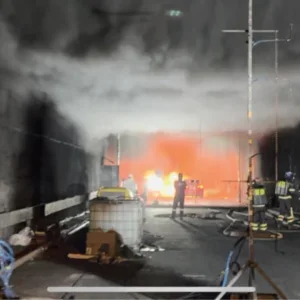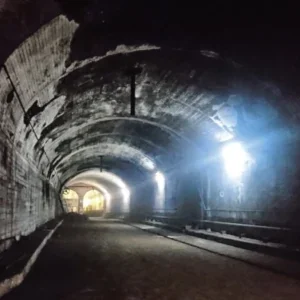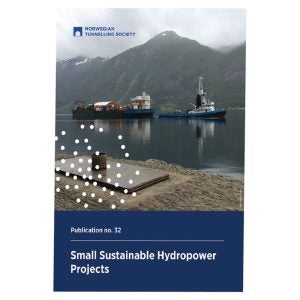Sparvo tunnel forms part of the Variante di Valico project in Italy. A 65.8km motorway link, the project is intended to upgrade the Apennines section of the motorway between Sasso Marconi and Barberino di Mugello in the undulating Emilia-Romagna region, and ease travel between the cities of Bologna and Florence.
Autostrade per l’Italia, Italy’s national road operator, divided the project into 13 lots. Contractor Toto Costruzioni Generali won four of these, including lots six and seven – the Sparvo Tunnel section. The project is noted for being the latest project to boast the world’s largest TBM, a 15.615m EPB manufactured by Herrenknecht.
Description of the plant
To ensure acceptable production, and to have enough space for the necessary storage, an area over 20,000sqm was chosen. It is located 2km from the southern entrance to the Sparvo tunnel. Toto performs the entire segment production process with 93 employees divided into three shifts, with 24-hour operation, six days per week.
Despite the high initial cost, a carousel system was selected to increase the rate of production. Four different sets of moulds are used, with each one ‘turning’ on tracks of the carousel. Euroform designed this system with the assistance of Toto specialists. An average daily production equal to 80 segments per day is assured, corresponding to eight complete rings.
After the completion of the first tunnel, Toto’s precast plant manager Gabriele Trovarelli decided to improve the carousel system by installing a hydraulic power pack to increase its translation speed. This modification permits a maximum production of 90 segments per day, due to the increase in power. The plant comprises three separate units for a total exploitable area equal to 5,800sqm.
Welding
The production starts with the manufacture of the steel reinforcement. In a 1,800sqm area there are nine workstations. A different cage is assembled in each workstation through the welding of steel bars supplied by Sofer Carpenterie. To maintain a healthy environment, mobile aspirators of noxious gas are installed, and a series of welding machines are fed gas by a centralised plant. Each shift has 15 employees. Air Liquide provided all the welding machines, gas distribution plant, and the aspiration system. The Stargon gas is supplied by Rivoira.
Placement
The reinforcement is later placed inside a mould at the start position of the carousel system; this last area takes up 2,800sqm and is arranged as an assembly line. Workers operate from fixed, protected positions while the equipment is moving:
- 1st position: segment de-moulding with a vacuum system and safety grabs;
- 2nd position: cleaning and disarming;
- 3rd position: dimensional control of the mould with a micrometer rod;
- 4th position: installation of the steel reinforcement;
- 5th position: general check, mould tightening and lateral closing;
- 7th position: is a soundproof cabin with a 5m3 casting bucket; near the cabin there is the control station where all casting stages are managed with the help of some cameras and a PLC malfunction detection;
- 9th position: complete closing of the mould (fresh concrete has no contact with the air).
- 6th and 8th positions are in case of extra operations. At the 2nd position, in order to ease de-moulding and to ensure the long-term usability of the moulds, the application of a chemical release agent, BASF Rheofinish 216, is constantly applied at the beginning of each cycle, following careful cleaning of the internal surface of the moulds.
After the 9th position, the closed mould is moved by the carousel to the entrance of the curing oven. The curing oven at 1,200sqm is a third of the total area of the plant. The opening of the oven bulkhead fixes the start of the thermal cycle.
Thermal cycle
The oven is divided into three sections with gradual temperature increases. In the first the temperature range is between 20-25°C, in the other two sections the temperature range is between 55-60°C. It’s regulated by a low-pressure steam injection system and contains three sets of moulds. Ten moulds are always on the workstation line while the remaining 30 are below the thermal cycle.
This permits a faster concrete curing through a temperature monitoring system; it has a minimum duration of nine hours. The thermal cycle is divided into pre-aging (one-and-ahalf to two hours), the thermal rise phase (one-and-a-half to two hours) and the aging phase (four hours at constant temperature). Precast elements are initially manufactured through a pre-aging phase with a constant temperature equal to 20°C in order to get a minimum strength, to avoid micro-cracks. During the thermal rise, or heating phase, the temperature in the oven is increased following a thermal gradient equal to 15-20°C per hour. Then, when the temperature is 55-60°C (maximum 65°C) it must be kept as consistent as possible for four hours.
As with the heating phase, the post-aging must be gradual in terms of concrete cooling to limit any cracking from uncontrolled shrinkage. Besides this, segments must be protected against concrete surface drying, and the core must also not exceed 50°C.
Close to the carousel system inside the plant, there is a temporary segment storage point where segments are immediately placed after removal from the oven and subsequent de-moulding. This manoeuvre avoids a thermal shock. The minimum curing time at this stage is 24 hours, then each segment is lifted and moved to toppling equipment where EPDM gaskets and guide bars are installed.
A large area of approximately 7,000sqm around the precast factory is used for segment temporary storage. A maximum of six elements are stacked with the intrados facing upwards. In this way the capacity of the storage area reaches around 2,500 segments (250 complete rings). The Cifa concrete mixing plant takes up a 500sqm area.
SegmenT lining design
Mix design
The tunnel lining is created through the assembling of a precast concrete, segmental ring with the use of a vacuum erector. Segments are to connected each other with steel bolts, while the longitudinal joints between adjacent rings are maintained by bi-block system. The hydraulic sealing of the ring is achieved with the application of EPDM gaskets on the external perimeter of each segment.
The tunnel design, due to the variable geomechanical and geological conditions, defines two different types of segments in terms of a 28-day concrete cubic strength. This is equal to 50MPa and 45MPa, respectively for types one and two. The fire resistance of precast segments was assigned as R120, while exposure class is relative to a ‘moderately aggressive environment’ XA2.
The mix design imposed the use of a pozzolanic cement and minimum three aggregate classes in accordance with UNI 8520/a with a maximum diameter as 20-25mm. The cement is supplied by Cementirossi while aggregates are supplied by Granulati Donnini. A consistency S4 is needed immediately before casting (measured by an Abrams cone, UNI EN 12350/2), and a watercement ratio equal to 0.42 is advised.
It’s of utmost importance to use a super plasticiser, with a common dosage of 0.8-1.5L per 100kg of cement. This reduces the need for water and produces a high quantity of hydration heat being based on modified polycarboxylic ether.
Steel reinforcement
As described, two classes of segments are produced by the precast plant: C40/50 (type 1) and C35/45 (type 2). The steel reinforcement requirements are:
- Type 1: Diameter of the bars at 18-16mm, and a rated steel weight/ concrete volume equal to 110kg/m3;
- Type 2: Diameter of the bars at 18-16mm, and a rated steel weight/ concrete volume equal to 90kg/m3;
Steel reinforcement distribution inside each segment was changed after early TBM advances due to a series of abnormal cracking processes. During excavation, the segments were stressed by particular load conditions applied by thrust cylinders in order to prevent the lowering of the TBM. These modifications did not involve the structural stability of the tunnel.
In order to define the cracking process, a series of real scale test were carried out with high pressure on thrust cylinders group D (300 bar equal to 24,938kN). Two loading configurations were applied to the segments: a symmetric load, and an asymmetric load applied respectively by the same thrust group (group D), and by two adjacent triple group of different thrust groups (group D and C or E).
All symmetrical tests showed the formation of a cracked area in the central part of the segment, between two thrust cylinders groups. This cracking process is due to an increase of the tensile stress between thrust groups. For the asymmetrical load, a cracking zone appeared in the unloaded part of the segment due to high tensile stresses.
In some cases cracks even appeared beneath the most loaded thrust cylinders shoe. To analyse the stress state of the segments a finite element model (FEM) was defined. In the symmetrical case (500 bar for each thrust group equal to 20,790kN) the model showed a high compressive stress under each cylinder and a tensile stress in the central area of the segment, this area extends up to 250mm from the edge of the segments. The FEM even detected a traction area at the segment edge opposite to thrust side. Its width is 300mm.
Showing steel
Following the previous results, steel reinforcement was thickened – reducing the diameter of the individual steel bars from 22mm to 16mm (without any modifications in terms of steel strength area/reinforcement effect) to control the cracking from unavoidable thermal shrinkage. During the concrete curing, simply due to the outstanding dimensions of the segments for the Sparvo project, temperature differences between the core and the external surface were greater than 20°C. Moreover, additional steel bars were also added in order to bear all tensile forces induced by the thrust cylinders. Some 18 bars of ø16mm in the first 250mm of the thrust side of the segments, and 12 bars of ø16mm inside the first 300mm on the opposite side of the segments.
To limit the spalling phenomena, the concrete cover was reduced to 30mm at the edge of the segments, and a series of welded wire meshes ø5mm, 100mm by 100mm were installed. The same arrangements were carried out on the type two segments. Using the steel reinforcement as described, no more cracks were observed on the segments.
CirCumferential and longitudinal joints
Longitudinal
The longitudinal connection between segments of adjacent rings is achieved with the bi-block system. Each segment is connected by four steel pins, while the key only needs two, making the total for each ring some 38 elements. Bi-blocks are easier and faster to assemble than bolts as they are put directly into their threaded PVC housing on the segments before being handled by the erector.
The positioning of each segment is more accurate than with the screwing of longitudinal bolts because the connector itself acts as a centering system. This means more safety for the employees, fewer misalignments and less time required to perform a ring build.
The bi-block system used in Sparvo Tunnel is BZ-160, supplied by FIP Industriale and consists of:
- A n°2 threaded PVC casing embedded in concrete and placed among the reinforcement bars with a specific guide reinforcement. The casings are made in Nylon PA-6 a plastic material impact-abrasion resistant with high elastic properties.
- A connecting steel pin (S235JR), inserted into its casing just before the segment loading on the segment feeder;
- A centering polypropylene bush (BE170M0).
The project requires pullout strengths greater than 185kN and shear strengths greater than 130kN.
To evaluate the mechanical performance of the bi-block system, the manufacturer carried out a series lab tests from July to September 2010.
This involved the casting of cubic samples with a perfect coupling of steel pin, casing and concrete. Pullout and shear strength tests showed strength characteristics higher than the designed values, a pullout strength of 211kN and shear strength in excess of 250kN.
In accordance with the wishes of Spea Ingegneria Europea, the division of Autostrade per l’Italia Group responsible for supervision of works, the Structures and Material Testings Laboratory of the Department of Civil Engineering at the University of Rome Tor Vergata performed a second series of tests to confirm all results provided by FIP and even to check special work conditions of these elements to simulate some assembly errors.
In detail, the second testing series covered shear strength tests; pull-out tests with the steel pin not fully inserted into the casing; pull-out tests with the steel pin not perfectly aligned in the casing but slightly inclined and pull-out tests with a greasy steel pin.
The strength tests carried out with these special conditions confirmed the reliability of this connection type. Average strength values were slightly lower than those ones in standard conditions. The maximum percentage difference among pullout strength test results was approximately 20 per cent, and it was recorded for a case where the steel pin was incorrectly inserted into the casing, however this result was still higher than the designed value.
Circumferential
The circumferential connection between adjacent segments in the same ring is achieved using special bolts; each joint is fixed by two steel bolts, for a total of 20 bolts in each ring.
FIP Industriale also manufactured these (TE28) steel bolts as a temporary circumferential joint. The technical specifications of the TE28 are: shank length: 727mm; shank diameter: 25mm; thread diameter: 28mm; thread length: 160mm; steel failure point: 800N/mm2; Steel yield point: 640N/mm2.
The design requirements of the steel bolts are: Steel failure load > 700N/mm2; steel yield point > 400 N/mm2; pull-out strength = 160kN; tightening = 60kN to compress the gasket along the radial joint between segments of the same rings. To ease ring building, the segments have a guide bar along the radial joints, so their contact faces have a semicircular housing with a radius of 27mm and a chamfer of 4mm with a 45 degree angle. The semicircular housing is able to ‘receive’ the guide bar and ease its slide into it.
The guide bar is made by polyethylene material and has a length of 800mm and a diameter of 50mm. Guide bars have no structural aims, however some laboratory test were carried out to characterise its material. Shear strength tests were carried out on two 100mm-long bar elements and an average shear strength of 400kN was reached.
Construction details
The segment lining is a universal type. Each ring is made by nine segments and one key that are 700mm thick and 2m long. The weight of each segment is in excess of 16t, while the key segment is more than 8t. The total ring weight reaches 157.22t. The outside ring diameter is 15m and the maximum internal diameter is 13.60m. It is the biggest and heaviest precast lining for a TBM in the world.
Water sealing gasket
To waterproof the tunnel, rubber seals are installed on the segments. The gaskets in use at Sparvo are FIP T184 EPDMs and it is applied along the entire perimeter of each segment (extrados side).
The geometrical characteristics of the gaskets are: base width 44mm, height 20mm (11mm housed and 9mm outside housing), EPDMs are characterised by a hardness (DIN 53505) in a range 70± 5 Shore A3, a failure load (DIN 53504) greater than 10N/mm2, an ultimate elongation greater than 300 per cent and a residual strain (24h/70°C; 25 per cent) less than 15 per cent. The gaskets have been tested at the same laboratory of the University of Rome mentioned previously. Watertightness and squeezing tests were carried out using the corner of a gasket to simulate its behavior in contact with the edge of the segment. Watertightness tests, performed in accordance with the STUVA ‘Recommendations for the use of gaskets for sealing segmental lining’ yielded the following results:
- Gap 3mm and offset 20mm: sealing pressure 50 bar;
- Gap 4mm and offset 20mm: sealing pressure 21 bar.
The safety factor applied on gasket sealing pressure is two, in order to consider its long-term life and a possible detensioning of the EPDM rubber. Squeezing tests showed a maximum reaction load of the gasket on the corner equal to 29.2kN. This value avoids spalling phenomena of the concrete of corners. It is also in agreement with the tests carried out by the MPA Bau Hannover laboratory, which indicate that spalling occurs for values higher than 230kN/m.
Tolerances and quality control
The quality control of the segments starts with an accurate check of the concrete mix. The concrete is produced with an automatic electronic control programmable logic controller (PLC) of aggregates, cement, additives and water during all production cycles, following a quality control plan to be daily accepted by Spea Ingegneria Europea. All raw materials must be in accordance with ISO 9001. Cement, water and additives are dosed with separate devices while aggregates through a cumulative weighted system for each granulometric class.
The PLC controls both the mix and the load sequence of the concrete components. Depending on the humidity measured by different sensors, it compensates the aggregates weight varying the water quantity. All scales and the volumetric equipments are periodically checked/calibrated by qualified centers using Italian Calibration Service (SIT) standards. Technical specifications of all dosing equipments are in accordance with UNI EN 206-1. All percentages are referred to the required quantities as specified in the concrete recipe.
Tests/checks are carried out by Toto Costruzioni Generali and Spea Ingegneria Europea. Concrete components, fresh/ hardened concrete characteristics and measuring equipments are monitored daily. Regarding the aggregates, the quality manager is responsible for checking:
- Humidity, on a weekly basis in order to verify no exceeding of tolerances;
- Sieve analysis (above all passing 0.075mm), done each 1,000m3 of material using UNI sieves (in accordance respectively with UNI EN 933-1 and UNI 8520-7);
- Imbibitions coefficient and volumic mass, done at the first delivery for new supply in accordance with UNI EN 1097;
- Sand equivalent and blue value have to be SE > 80 and VB < 0.6 cm3/g carried out each 8,000m3 of material in accordance with EN 933-9 and EN 933-8;
- Presence of reactive minerals, each 8,000m3 of material in accordance with UNI EN 8520-4 and EN 932-3;
- Presence of sulphates (SO4 < 0.05%) and soluble chlorides (Cl < 0.05%), tests carried out in case of doubts and each 8000 m3 of material in accordance with EN 1744-1;
- Presence of organic substances, tests performed in case of doubts and each 8,000m3 of material in accordance with UNI 8520-14 and EN 1744-1;
- Alkali reactivity, tests are done each 8,000m3 of material in accordance with UNI 8520-22; Additives and cement are checked at each delivery in terms of quality in order to confirm the label and CE conformity. Water is tested through chemical analysis to check the contents of organic substances and chlorides, for the first use of non-potable water, and in case of doubt (in accordance with UNI EN 1008). Concrete is qualified through a complex control plan:
- Fine aggregates humidity, in order to estimate the dry mass of the aggregates. For each delivery the humidity is checked with probes on a weekly basis, or with more frequency depending on the climatic conditions by drying tests;
- Coarse aggregates humidity, in order to estimate the dry mass of the aggregates by test of drying weekly, or with more frequency depending on the climatic conditions;
- Water content of fresh concrete to evaluate the consistency of the concrete. This test is carried out daily with an Abrams Cone in accordance with UNI EN 12350-2 or -3, -4, -5;
- Fresh concrete temperature, each 300m3 of mix. The temperature must be more than 10°C;
- Compressive cubic strength of concrete (28 days) is monitored daily, withdrawing a series of cubic specimens during the casting phase in accordance with UNI EN 12390-3 to evaluate its correct failure.
Scheduled controls are performed by instrumentation able to discretise 0.1mm. Each mould is checked daily, providing correction if needed.
advance improvements
During the advance of the excavation of the Sparvo tunnel, due to particular work conditions, four Elastomat load spreading pads of 400 by 500mm have been installed on each of the segments on the side in contact with the ring previously mounted. This avoids spalling phenomena. The pads are made by elastomerised bitumen, with the addition of SBS rubbers and polyester reinforcements. Their aim is to protect the concrete of the segments during the ring build. In addition, at the four corners between the EPDM gasket and the extrados, four 800mm-long stripes of bentonitic seals (Bento-FIP TMZ) were installed. These additional seals, which expand up to four times their original volume upon contact with water, create an elastic and compact shield, which waterproofs the tunnel in case of splintering at the corners.






